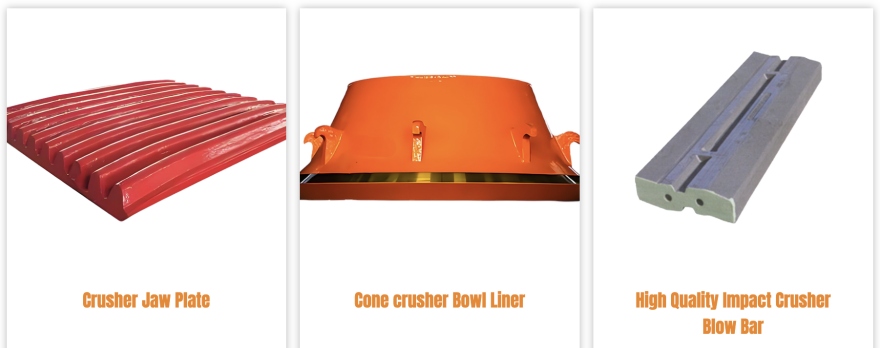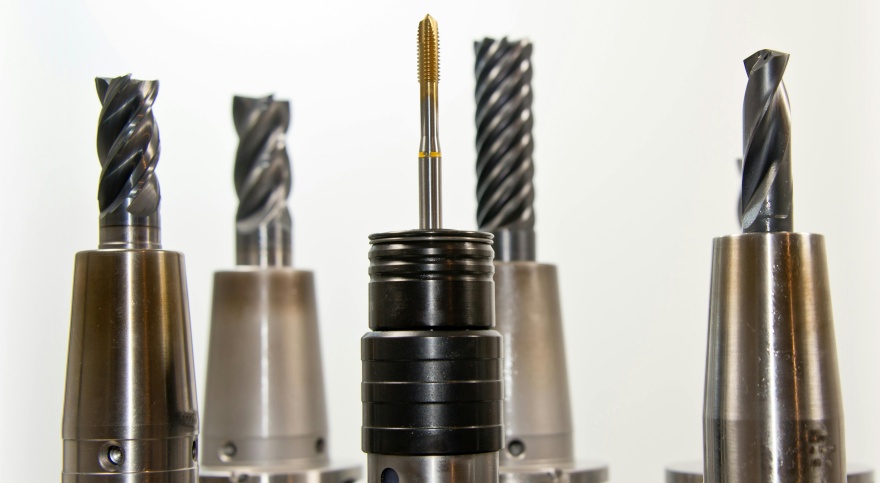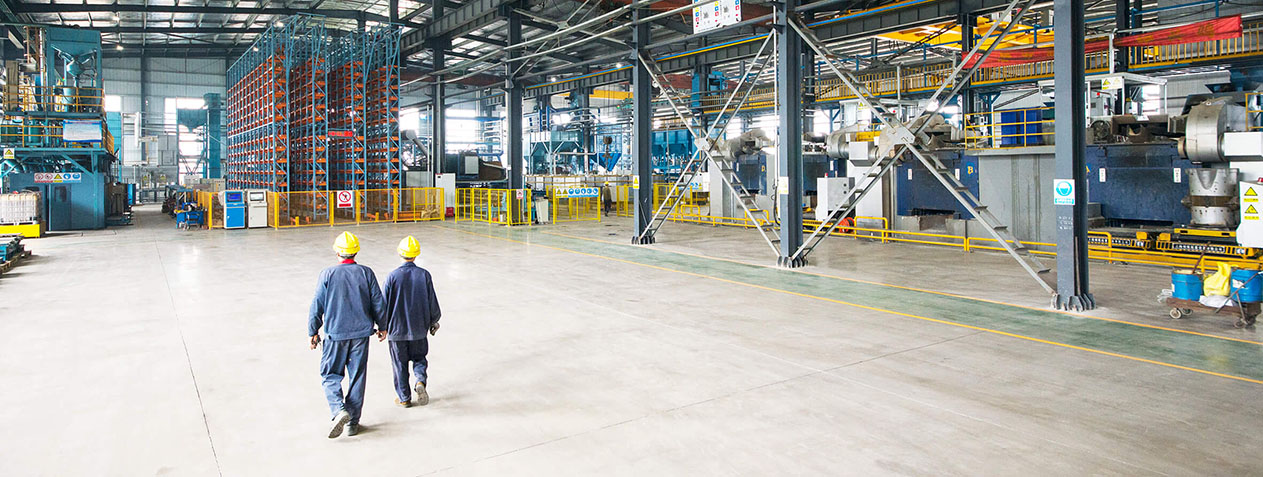Machinery and equipment are essential to numerous industries, ranging from mining and construction to manufacturing and transportation. To ensure continuous operation and efficiency, the timely replacement of components is vital. Two critical categories of replacement components are wear parts and spare parts. Although these terms are often used interchangeably, they serve distinct purposes in maintaining equipment. This article aims to clarify the differences between wear parts and spare parts, shedding light on their roles and importance in maintenance and operations.
Wear parts, or wear-resistant parts, are specially designed and manufactured parts used to withstand friction, abrasion and other forms of wear that occur during the operation of machinery and equipment. These wear parts play a critical role in enhancing the durability and longevity of equipment by reducing the impact of mechanical wear caused by repetitive contact, pressure, and harsh working conditions.

Material Composition:
Wear-resistant parts are typically made from high-strength materials, such as hardened steel, cast iron, tungsten carbide, ceramics, or specially treated alloys. The choice of material depends on the application and the specific wear mechanisms involved.
Surface Treatment:
Many wear-resistant parts undergo additional treatments like heat treatment, nitriding, carburizing, or surface coating with wear-resistant materials (e.g., chromium, nickel, or titanium compounds) to further enhance their resistance to abrasion and corrosion.
Durability:
Designed to operate under extreme conditions, wear-resistant parts resist deformation, cracking, and other forms of mechanical failure, ensuring consistent performance over extended periods.
Mining and Construction:
Wear-resistant parts such as crusher liners, tooth plates and blow bars are required in mining, aggregate plants, cement manufacturing and other processes to handle abrasive materials such as rocks, sand and ores.

Concrete Machinery:
Wear parts such as liners, mixing arms, scrapers, seals, blades, etc. in concrete mixing plants ensure that concrete mixing plants can maintain durability and efficiency even in the harshest environments; parts such as pipe clamps, pump elbows and straight pipes in concrete pump trucks must resist the abrasive effects of aggregates and cement.

Asphalt Machinery:
Asphalt machinery includes smelting equipment, asphalt mixing plants, asphalt pavers, stabilized soil mixing plants and other equipment. Wear-resistant parts include smelting equipment hammers, asphalt mixing plant liners, asphalt paver spiral blades, stabilized soil mixing plant blades, etc. These wear parts are made of highly wear-resistant, high-toughness, corrosion-resistant and high-temperature resistant materials, and are specially designed to handle the abrasive and high-temperature conditions in the asphalt mixing and paving process.

Metallurgical industry
Sand making machine linings, sand making machine hammers, coal mill grinding balls and other wear parts can withstand severe wear and high temperatures during sand making and coal grinding.

Agriculture:
Components like plowshares, cultivator points, and harvester blades endure constant friction against soil and crops.
Oil and Gas Industry:
Drilling and pumping equipment rely on wear-resistant components to withstand harsh environmental conditions and abrasive substances.
Transportation:
Railways and heavy vehicles use wear-resistant brake pads, gears, and other components to ensure safety and efficiency.
Liners and Plates: Protect surfaces subjected to constant impact or friction.
Cutting and Drilling Tools: Include bits and blades designed to endure abrasive materials.
Pump and Valve Components: Resist erosion and corrosion in fluid handling systems.
Bearings and Seals: Reduce wear in rotating and sliding mechanisms.
Extended Equipment Life: Reduces the need for frequent replacement of parts, saving maintenance costs.
Enhanced Operational Efficiency: Minimizes downtime caused by part failure, ensuring continuous operation.
Cost-Effectiveness: Prevents premature wear and tear, reducing overall equipment costs.
Sustainability: Promotes efficient resource utilization by minimizing waste generated from frequent part replacements.
Wear-resistant parts are essential for industries aiming to improve operational efficiency and reduce costs in challenging environments. Their development involves advanced material science and engineering to meet the evolving demands of modern machinery and applications.
Spare parts, on the other hand, are general components that are used to replace damaged, malfunctioning, or broken parts in machinery. Unlike wear parts, spare parts are not necessarily subject to regular wear but are vital for the functionality and operation of equipment. Examples of spare parts include motors, sensors, belts, and gears. These parts are often kept in stock to address unexpected failures or breakdowns, minimizing equipment downtime and ensuring operational continuity.

Understanding the differences between wear parts and spare parts is crucial for effective maintenance and inventory management. Here are the key distinctions:
| Wear parts | Spare parts | |
| 1. Purpose: | Replace components that degrade due to regular use and exposure to operational conditions. | Replace components that fail unexpectedly or are damaged. |
| 2. Frequency of Replacement: | Require frequent replacement as part of planned maintenance schedules. | Replaced unpredictably, depending on the occurrence of malfunctions or accidents. |
| 3. Material and Design: | Engineered for durability, often using materials like high-chromium alloys or ceramics to resist abrasion. | Designed for compatibility and functionality, focusing on restoring the original performance of the equipment. |
| 4. Cost Consideration: | Generally less expensive per unit but need more frequent replacements, leading to cumulative costs. | Higher initial cost but typically replaced less frequently, making them strategic investments. |
Knowing the difference between wear parts and spare parts can have significant benefits for businesses, including:
Wear Parts: These are consumables that experience gradual deterioration due to consistent use and need periodic replacement. Businesses can stock these parts in larger quantities to ensure continuous operations.
Spare Parts: These are less frequently replaced and often reserved for unexpected failures. By differentiating between the two, businesses can prioritize inventory to minimize overstocking or understocking.
Benefit: Saves costs associated with excessive inventory while reducing downtime from part unavailability.
Wear Parts: Replacement schedules for wear parts can be predicted based on usage patterns and environmental conditions.
Spare Parts: Typically replaced during major breakdowns or planned overhauls.
Benefit: Businesses can develop a more precise maintenance schedule, avoiding unscheduled downtime and improving equipment uptime.
Regular replacement of wear parts prevents damage to machinery components, avoiding costly repairs.
Maintaining a ready supply of spare parts ensures that critical equipment can be quickly restored in the event of unexpected failures.
Benefit: Balancing investments between wear parts and spare parts reduces operating costs and extends the overall life of machinery.
With wear parts replaced at the right intervals, machines can operate at peak efficiency.
Quick access to spare parts ensures that unexpected issues don’t disrupt production.
Benefit: Increases productivity and reduces downtime across operations.
Differentiating wear parts from spare parts allows businesses to negotiate better procurement terms, such as bulk discounts for frequently used wear parts or custom manufacturing agreements for critical spare parts.
Benefit: Achieves cost savings and ensures reliable supply chains.
Regular replacement of wear parts minimizes wear on key components and prevents damage to the machinery's core structure.
Using high-quality spare parts ensures that replacements maintain the original performance standards of the equipment.
Benefit: Maximizes the lifespan of expensive machinery, providing a higher return on investment.
Different industries provide clear examples of the different roles of wear and spare parts, highlighting their key contribution to operational efficiency:
Wear parts: Crusher wear liners and hammers are designed to withstand constant wear and tear from ore and rock materials and need to be replaced regularly to maintain optimal performance.
Spare parts: Conveyor belts, gearboxes and motor components are critical to overall equipment functionality and can be used as spare parts to replace worn or faulty systems.
Wear parts: Excavator teeth and bucket edges face tremendous friction and impact during digging and loading operations and need to be replaced regularly to maintain efficiency.
Spare parts: Hydraulic pumps, filters and engine parts are essential to ensure the continuous operation of heavy machinery and are replaced as needed due to failure or wear.
Wear parts: Cutting tools such as drill bits, grinding wheels and machine blades are subject to severe wear due to repeated movement and contact with materials.
Spare parts: Motor components, control panels and bearings can be used as spare parts to ensure seamless operation in the event of unexpected failures.
Wear Parts: Plowshares, harvester blades and seed tray openers are constantly worn by soil, crops and debris and therefore need to be replaced regularly.
Spare Parts: Hydraulic systems, tires and engine components are important spare parts to maintain machine functionality during failures.
Wear Parts: Drill bits and wellbore stabilizers are subject to intense wear and pressure and therefore need to be replaced frequently.
Spare Parts: Pump, valve and compressor parts ensure continuity of operation in the event of a failure in the main system.
Other examples: Downhole tools are wear parts, while pipe flanges and actuators serve as spare parts.
Effective management of wear parts and spare parts is essential to maintaining operational efficiency. Here are some strategies:
Predictive Maintenance for Wear Parts: Regularly monitor the condition of wear parts to replace them before they fail.
Stocking Critical Spare Parts: Ensure that essential spare parts are readily available to reduce downtime during unexpected failures.
Reliable Supply Partnerships: Collaborate with dependable suppliers to guarantee timely delivery of both wear parts and spare parts.
Haitian Heavy Industry Technology Development Co., Ltd. is a leading company dedicated to the research and development and production of high-performance wear-resistant materials. Haitian Heavy Industry focuses on innovation and quality, providing customized cutting-edge solutions for wear parts that meet the stringent requirements of industries such as mining, construction and concrete mixing.
Haitian Heavy Industry specializes in the design and manufacture of wear parts for mining equipment and concrete mixing plants, including:
Crusher wear parts: high-durability parts designed to withstand abrasive environments to ensure optimal crusher performance.
Concrete mixing plant wear parts: rugged and reliable solutions that increase the service life and efficiency of concrete production equipment.
If you are looking for a wear parts supplier, then Haitian will be your trusted partner, providing high-quality wear parts and advanced material solutions to ensure that your machine can run at optimal performance every time.

While wear parts and spare parts are both essential for maintaining machinery, they serve distinct roles and are managed differently. Wear parts require frequent replacement due to regular wear and tear, while spare parts address unexpected malfunctions and failures. Understanding these differences is key to effective maintenance planning, cost management, and operational efficiency. By prioritizing proper inventory management and maintenance strategies, businesses can maximize the longevity and performance of their equipment.